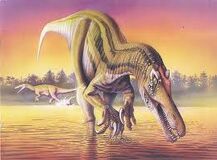No edit summary |
No edit summary |
||
| Line 9: | Line 9: | ||
Diet: Piscivorous |
Diet: Piscivorous |
||
==Discovery and Naming== |
==Discovery and Naming== |
||
| − | Baryonyx fossils were first discovered in a clay pit in Surrey. Amatuer fossil hunter William Walker discovered a massive claw belonging to Baryonyx in January 1983. The claw went to the Natural History Museum in London, and is still there to date. More fossils were then discovered, and the new dinosaur was named Baryonyx walkeri. Baryonyx means heavy claw, and walkeri refers to its discoverer. Since then fossils have been found in Spain and Portugal. |
+ | Baryonyx fossils were first discovered in a clay pit in Surrey. Amatuer fossil hunter William Walker discovered a massive claw belonging to Baryonyx in January 1983. The claw went to the Natural History Museum in London, and is still there to date. More fossils were then discovered, and the new dinosaur was named Baryonyx walkeri. Baryonyx means heavy claw, and walkeri refers to its discoverer. Since then several fossils have been found in Spain and Portugal. |
==The Claw== |
==The Claw== |
||
| − | The claw on the thumb of Baryonyx was the first fossil evidence of it discovered. It was curved, and ended in a point, with a total length of 35cm. Baryonyx would have probably used it to spear fish, which it ate. Baryonyx was also named after its claw, that being "heavy claw". |
+ | The claw on the thumb of Baryonyx was the first fossil evidence of it discovered. It was curved, and ended in a point, with a total length of 35cm. Baryonyx would have probably used it to spear fish, which it ate. Baryonyx was also named after its claw, that being "heavy claw". |
==Diet== |
==Diet== |
||
Baryonyx was probably a piscivore. Two of its features support this idea - firstly, the claw could have been used to spear fish as they leaped out of the water, and its jaws were crocodile-like, ideal for eating fish. Also, it had conical teeth, ideal for holding slippery fish. Even so, Baryonyx may have scavenged dinosaur carcasses as well. |
Baryonyx was probably a piscivore. Two of its features support this idea - firstly, the claw could have been used to spear fish as they leaped out of the water, and its jaws were crocodile-like, ideal for eating fish. Also, it had conical teeth, ideal for holding slippery fish. Even so, Baryonyx may have scavenged dinosaur carcasses as well. |
||
Revision as of 15:16, 21 January 2011
Baryonyx is a piscivore from the Hauterivian and Barremian stages of the Early Cretaceous, 130 - 125 million years ago.
Fact File

An illustration of Baryonyx
Length: 11 metres
Height: 4 metres
Weight: 2-3 tonnes
Diet: Piscivorous
Discovery and Naming
Baryonyx fossils were first discovered in a clay pit in Surrey. Amatuer fossil hunter William Walker discovered a massive claw belonging to Baryonyx in January 1983. The claw went to the Natural History Museum in London, and is still there to date. More fossils were then discovered, and the new dinosaur was named Baryonyx walkeri. Baryonyx means heavy claw, and walkeri refers to its discoverer. Since then several fossils have been found in Spain and Portugal.
The Claw
The claw on the thumb of Baryonyx was the first fossil evidence of it discovered. It was curved, and ended in a point, with a total length of 35cm. Baryonyx would have probably used it to spear fish, which it ate. Baryonyx was also named after its claw, that being "heavy claw".
Diet
Baryonyx was probably a piscivore. Two of its features support this idea - firstly, the claw could have been used to spear fish as they leaped out of the water, and its jaws were crocodile-like, ideal for eating fish. Also, it had conical teeth, ideal for holding slippery fish. Even so, Baryonyx may have scavenged dinosaur carcasses as well.